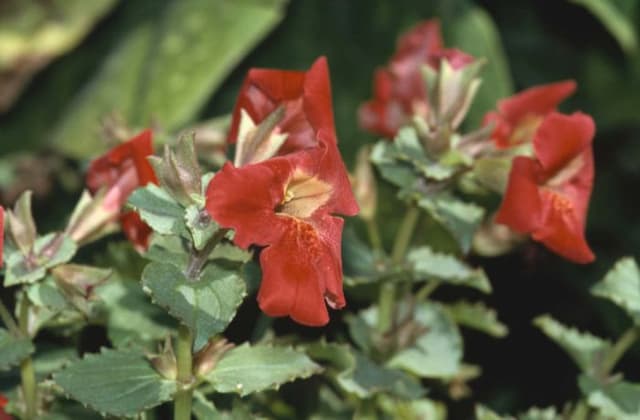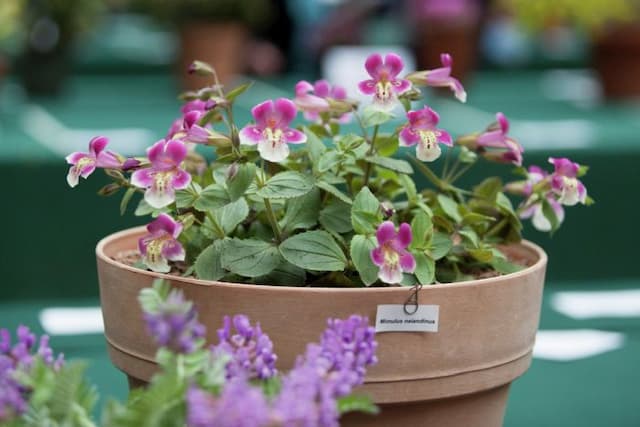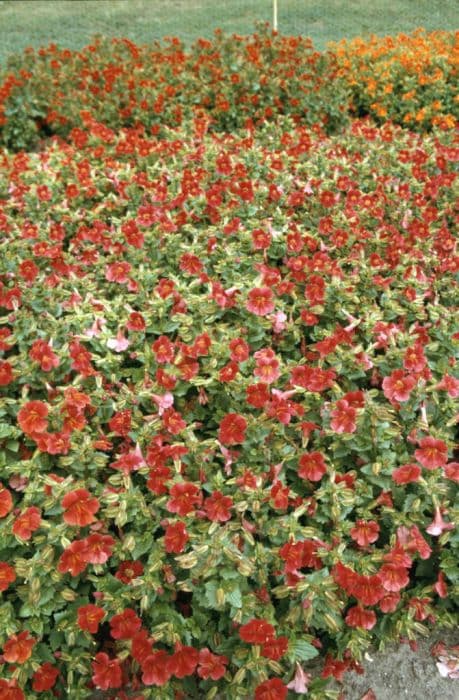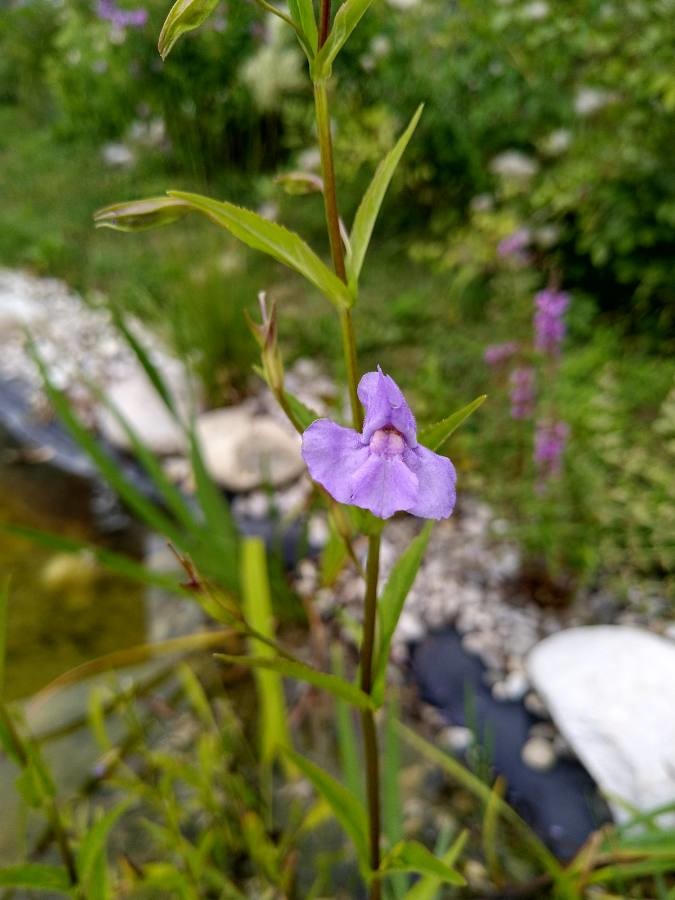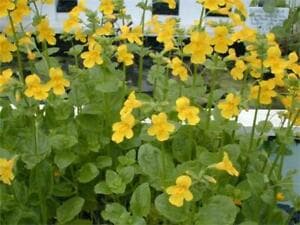Monkey Flower Mimulus cupreus 'Whitecroft Scarlet'

ABOUT
Mimulus cupreus 'Whitecroft Scarlet', commonly known as monkey flower, is a vibrant and eye-catching plant known for its vivid scarlet-colored blossoms. The flowers stand out with their tubular shape and flared mouth, resembling the face of a monkey, hence the common name. Each flower is comprised of five petals, with the three lower ones often having some degree of speckling or markings that add to their ornamental appeal. The foliage of the monkey flower is equally attractive, typically presenting a rich green color that contrasts beautifully with the scarlet flowers. The leaves are generally oval-shaped with pointed tips and can have a slight serration on the edges. The texture of the leaves is somewhat soft, adding a lush appearance to the overall foliage. This plant tends to have a bushy growth habit, often forming clumps that are dense with both leaves and blooms. The visual impact of the monkey flower is characterized by its abundant flowering, with the blossoms densely packed atop the stems, creating a striking display of color. Monkey flower is favored in gardens for its show-stopping blooms and is often used in borders, containers, or as a colorful accent in mixed plantings, where its rich, scarlet flowers can create a focal point of intense color. The contrast between the fiery red petals and the verdant green leaves makes this plant a highly decorative addition to any planting scheme.
About this plant
 Names
NamesFamily
Phrymaceae
Synonyms
Monkey Flower, Coppery Monkey Flower
Common names
Mimulus cupreus 'Whitecroft Scarlet'.
 Toxicity
ToxicityTo humans
Monkey flower is generally considered non-toxic to humans. This means that ingesting parts of the monkey flower is not expected to cause symptoms of poisoning or harmful effects. However, it is always advisable to be cautious and avoid eating ornamental plants as they are not intended for consumption.
To pets
Monkey flower is also typically considered non-toxic to pets. Ingesting this plant is unlikely to lead to poisoning or produce adverse health effects in pets like dogs and cats. Nonetheless, individual animals might react differently to certain plants, and eating non-food items can sometimes lead to gastrointestinal upset. It is still prudent to prevent pets from consuming ornamental plants to avoid any potential issues.
 Characteristics
CharacteristicsLife cycle
Perennials
Foliage type
Deciduous
Color of leaves
Green
Flower color
Scarlet
Height
1 foot [30 cm]
Spread
1 foot [30 cm]
Plant type
Herb
Hardiness zones
9
Native area
Chile
Benefits
 General Benefits
General Benefits- Aesthetic Appeal: The Mimulus cupreus 'Whitecroft Scarlet', commonly known as Monkey flower, offers vibrant scarlet flowers that add a splash of color to gardens and landscapes.
- Attracts Pollinators: The bright flowers attract bees, butterflies, and other pollinating insects, supporting local ecosystems.
- Low Maintenance: Monkey flower is relatively easy to grow and doesn't require extensive care, making it a suitable choice for gardeners of all skill levels.
- Drought Tolerance: Once established, it is quite resilient to dry conditions, reducing the need for frequent watering.
- Cool Weather Resilience: The plant can tolerate cooler temperatures, which allows it to thrive in a variety of climates.
- Fast Growing: Monkey flower grows quickly, which can be rewarding for gardeners looking to see results in a short period of time.
- Versatile: It can be used in mixed borders, containers, and as a bedding plant, providing flexibility in garden design.
- Edging Plant: Its compact size and spreading habit make it ideal for use as an edging plant in garden beds.
 Medical Properties
Medical PropertiesThis plant is not used for medical purposes.
 Air-purifying Qualities
Air-purifying QualitiesThis plant is not specifically known for air purifying qualities.
 Other Uses
Other Uses- As a unique natural dye: The striking scarlet color of the Monkey Flower can be used to create natural fabric dyes.
- Photography subject: With its vibrant color and unique shape, Monkey Flower serves as an excellent subject for botanical photography.
- Education: It can be used in school projects or botanical studies to teach about pollination and the diversity of plant species.
- Ecosystem indicator: Monkey Flower might serve as an indicator species in its native habitat, reflecting the health of the local ecosystem.
- Art inspiration: The bright colors and form of Monkey Flower can inspire artists to create paintings, illustrations, and other artworks.
- Garden design: Monkey Flower can be used by landscape designers to create a focal point in gardens, due to its attractive appearance.
- Thematic gardening: It can be incorporated into a fire-themed garden for its scarlet blossoms reminiscent of flames.
- Drama and storytelling: Monkey Flower can be used in plays or storytelling as a prop or a symbol due to its striking appearance.
- Special events decoration: The flowers could be used to decorate event spaces for celebrations, adding a bright pop of color.
- Bee and butterfly gardening: Since the Monkey Flower attracts pollinators, it can be used in gardens designed to attract and support these insects.
Interesting Facts
 Feng Shui
Feng ShuiMimulus is not used in Feng Shui practice.
 Zodiac Sign Compitability
Zodiac Sign CompitabilityMimulus is not used in astrology practice.
 Plant Symbolism
Plant Symbolism- Courage and Fearlessness: The Mimulus genus is often associated with courage because its name comes from the Latin word for "mimic," in reference to the face-like appearance of its flowers. Mimulus cupreus, also known as Monkey Flower, represents the ability to confront fears and challenges with bravery.
- Overcoming Anxiety: Monkey Flower is associated with overcoming anxiety or nervousness, as it is used in flower essences to treat these emotional states. It symbolizes finding peace and calm in stressful situations.
- Playfulness: Given the whimsical appearance of the Monkey Flower, it often symbolizes playfulness and a sense of humor. It reminds us to find joy and light-heartedness in life.
- Protection: Flowers in general can symbolize a sense of protection and care. The Monkey Flower, with its bright color and sturdy form, can suggest a protective quality.
- Adaptability: As a plant that can grow in a variety of conditions, the Monkey Flower symbolizes the ability to adapt and thrive in diverse environments, reflecting the resilience of nature and the human spirit.
 Water
WaterMonkey Flower, or Mimulus cupreus 'Whitecroft Scarlet', prefers consistent moisture, so it should be watered regularly. During the growing season, water it at least once a week, ensuring the soil remains moist but not waterlogged. The amount of water can depend on the climate and soil drainage but expect to use approximately 1 to 1.5 gallons per week for an average-sized plant. Adjust the watering frequency during extreme heat or drought to possibly twice a week, and reduce it during cooler, rainy periods to prevent overwatering. Always check the top inch of soil for dryness before watering again.
 Light
LightMonkey Flower thrives best in partial shade to full sun conditions. Ideally, choose a spot where the plant will receive morning sunlight and some afternoon shade to protect it from the intense heat of the day. The plant can also grow in dappled sunlight under the canopy of larger trees, which replicates its natural woodland habitats.
 Temperature
TemperatureMonkey Flower does well in a range of temperatures, but it prefers moderate conditions. It can survive minimum temperatures down to about 30 degrees Fahrenheit, but frost can damage the plant. The plant's ideal temperature range is between 60 to 75 degrees Fahrenheit, and it may struggle in temperatures above 90 degrees Fahrenheit.
 Pruning
PruningTo encourage bushier growth and more blooms, prune Monkey Flower in early spring or after a flush of flowers fades. Remove spent flower stems and prune back leggy growth to shape the plant, doing so every few months during the growing season. Pruning also helps prevent disease by increasing air circulation within the plant.
 Cleaning
CleaningAs needed
 Soil
SoilMonkey Flower prefers well-draining, moist soil rich in organic matter with a slightly acidic pH of 6.0 to 7.0. A good mix could be equal parts loam, peat, and sand to ensure adequate drainage and fertility.
 Repotting
RepottingMonkey Flower typically doesn't require frequent repotting and can be done every 1-2 years, or when the plant outgrows its container, to refresh the soil and provide room for growth.
 Humidity & Misting
Humidity & MistingMonkey Flower thrives best at moderate humidity levels; aiming for around 40-50% relative humidity is suitable for their growth and flowering.
 Suitable locations
Suitable locationsIndoor
Place Monkey Flower in bright, indirect light and keep soil moist.
Outdoor
Grow Monkey Flower in partial shade and moist, well-drained soil.
Hardiness zone
9-11 USDA
 Life cycle
Life cycleMimulus cupreus 'Whitecroft Scarlet', commonly known as 'Monkey Flower', begins its life as a seed, typically sown in early spring under cover or directly outdoors once the danger of frost has passed. Seedlings emerge and grow, forming a compact, herbaceous structure with a rooting system. As the plant matures, it develops lush green foliage and starts to produce its distinctive scarlet flowers usually by mid-to-late spring or early summer. The flowering phase can last through summer, attracting pollinators such as bees and butterflies. After pollination, the flowers will produce seeds that ripen by late summer or early fall. Eventually, as the temperatures cool and day lengths shorten, the monkey flower completes its annual life cycle by senescing, the plant withers and dies back, relying on its seeds to perpetuate the next generation.
 Propogation
PropogationPropogation time
Spring-Early Summer
Propogation: Mimulus cupreus 'Whitecroft Scarlet', commonly known as Monkey Flower, is typically propagated by cuttings. This method is popular due to its effectiveness and relative simplicity. To propagate Monkey Flower via cuttings, select a healthy, non-flowering shoot during early summer. Cut a 2-4 inch (5-10 centimeter) piece just below a leaf node, and remove the lower leaves to expose the node. Dip the cut end into a rooting hormone to encourage root growth. Then, insert the cutting into a pot filled with moistened potting soil or a soilless medium. Cover the pot with a plastic bag or place it in a propagator to maintain humidity, and keep it in bright, indirect light. Roots should develop within a few weeks, after which you can gradually acclimatize the new plant to ambient conditions before planting it out.
